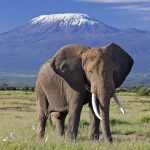Health Issues you can encounter when climbing Mount Kilimanjaro.
This are major health issues you may encounter while taking on the challenge to hike Mount Kilimanjaro
Acute Mountain Sickness (AMS)
Acute Mountain Sickness is also referred to as “Altitude Sickness” as the name indicates the illness is commonly encountered at exceptionally high altitudes, such as the summit area of Mount Kilimanjaro. This is a very common issue about 3 out of 4 hikers will suffer to some extent from the altitude sickness, it is therefore important to familiarize yourself with this condition and preventive measures
Cause of altitude sickness “AMS”, as altitude increases the number of oxygen molecules per breath is reduced. At about 12000 feet (3600m) there is about 40% fewer oxygen molecules per breath so the failure of the body to adapt quickly to the reduced oxygen causes altitude sickness
The symptoms of altitude sickness “AMS” include in the order normally experienced; headaches, nausea, anorexia, exhaustion, lassitude, rapid pulse, insomnia, swelling of the hands and feet and reduced urine output.
What to do if you get altitude sickness “AMS”, the most effective treatment will be by immediately taking the affected person to a lower altitude. Often a drop as little as 500m will be sufficient.
Preventive measures to avoid of altitude sickness “AMS”, Climbers can take precautions to at least minimize the severity of the illness
- by maintaining a slow steady pace from day one giving enough time for your body to adapt to the altitude. “pole pole” is a common Swahili phrase translating to slowly, which is now a norm among hikers climbing Mount Kilimanjaro
- including an extra day of acclimatization at a high altitude
- drinking at least 3-4 liters of water every day.
- Preventative medicine is also available and you should consult your physician for specialist advice.
Note: altitude sickness is the most common of the Kilimanjaro health issues be sure to follow preventive measures above
Altitude sickness can be serious
Most hikers get minor effects of altitude sickness that they can hike through but to some it can get severe inability to walk, shortness of breath at rest, fluid buildup in the lungs.
Fluid build-up may cause a condition known as edema, which can affect your lungs (High Altitude Pulmonary Edema) preventing effective oxygen exchange or affect the brain (High Altitude Cerebral Edema) which will result in the swelling of the brain tissue. The latter can be lethal if not treated immediately.
Tip: it is essential you communicate any symptoms immediately to others, if symptoms persist or increase (severe headache, decreased coordination “ataxia”, weakness, fatigue, nausea, shortness of breath) means you will be suffering moderate AMS and you will be required to descend as at this stage only a descend or advanced medication can reverse the problem. It is important to descend before the ataxia reaches a point you can walk on your own.
Hypothermia
Hypothermia is the lowering of the body’s core temperature.
- Cause, if you clothing get wet or perspiration meaning the cold will now be under your clothing layers and will lead to falling of your body temperature
- Prevention, correct equipment and clothing is critical, proper layers of clothing (moisture wicking fabric) will prevent hypothermia (see full packing list guideline).
- Treatment, is by getting to a shelter, removing all wet clothing and getting the victim warm (placing him/her inside two or three sleeping bags preferably with another person)
Sun related injuries
About 55% of the earth’s protective atmosphere is below an altitude of 5000m. Far less ultraviolet light is being filtered out, making the sun’s rays much more powerful, which could result in severe sun burning of the skin.
Preventives
- It is strongly recommended to use a 20+ sun protection cream at lower altitudes,
- total block cream above an altitude of 3000m.
- It is also important to wear dark sun glasses preferably with side panels above 4000m in daytime and essential when walking through snow or ice. Snow blindness can be very painful, and will require your eyes to be bandaged for at least 24 hours.
Fitness
Any climber who suffers from any cardiac or pulmonary problems should be cautious and should not attempt to climb the mountain unless they have consulted their physician. It is strongly recommended that a physical fitness program is followed to prepare yourself physically for the mountain.
Foot problems
Causes
- Poor fitting, new or little used boots will result in blistering feet. Even if boots are only slightly to small, your toes will get bruised, particularly on your descend.
Prevention
- It is it therefore also important to keep your toe nails short for the climb.
- Developing blister should be treated immediately as soon as the “hot spot” is felt. Remove the boot and cover the area with a zinc oxide tape or something similar.



















